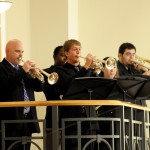J.S. Bach School for Trombone Liner Notes
J.S. Bach School for Trombone
The music of J.S. Bach is such a joy to work on and play. Unfortunately, aside from trombone parts in a few cantatas, Bach wrote nothing specifically for trombone as far as we know. So what is the J.S. Bach School for Trombone? In 2010 I recorded Ralph Sauer’s trombone quartet arrangement of Bach’s Art of Fugue on alto, tenor and bass trombones. I advanced in so many areas as a player working on this multi-track recording that it seemed wise to record more of Bach’s music in order to go further, to build up weak areas of my playing. For me, Bach’s music is so compelling, so melodically rich; returning to it was an easy choice. The J.S. Bach School for Trombone is therefore a practice project, which I share with the expectation that it will have the same good effect for others it has had for me. In addition, the score provides trombone specific solutions for performing Bach’s ornaments, which can be heard in the recordings, whose voices are offered individually as practice tracks. The 15 two part Inventions BWV 772-786 and 15 three part Sinfonias BWV 787-801 are the text for this school because they are short, loaded with great imitative counterpoint, full of technical challenges that demand accuracy and stamina in various major and minor keys. Their musical rewards make me run to practice them! And they are effective; I wish I had tackled this project prior to recording Art of Fugue.
The J.S. Bach School for Trombone is designed to expand ability in the upper register of the alto trombone and the ‘cash’ register of the bass trombone, i.e. the notes below the bass staff. Since I am not a bass trombonist by trade this area has been my weakest. I also wanted to maintain Bach’s intervals between voices, a feature no other trombone arrangement of this music offers. To achieve this I simply lowered all 30 pieces a perfect fifth. That’s it; no octave displacements or crossing voices. The result? This stuff is quite a bit harder than Ralph Sauer’s Art of Fugue arrangement, at least for me. The top voice requires real agility up to high f2 on alto and the bass voice requires the same down to pedal FF. Hearing just how bad I sounded at the start and then devising ways to get, not a perfect, but just an acceptable recording of challenging passages is both brutal and thrilling at the same time. Tone production and technique have to develop together. Musically, it’s great to experience the proper interval between voices but lowering the whole experience a fifth challenges brilliance of sound.
Here is the equipment used on the recording:
- Top voice – Conn 36h alto trombone with B-flat attachment, Greg Black custom mouthpiece similar internally to Bach 18
- Middle voice (Sinfonias only) – Bach 36 with detachable F attachment, David Houser custom mouthpiece, similar internally to Mt. Vernon Bach 5GS
- Bottom voice – Conn 62 bass trombone with independent F/G-flat Lindberg valves, CKB 1 1/2G stock mouthpiece and Schilke 60 customized for Bruce Nelson
- AKG C214 microphone into Audient iD14 interface into ProTools 11 running on Windows 7 platform
The recording is designed for practice and enjoyment and is offered in seven different configurations.
- Complete recording with all voices sounding
Inventions
- without top voice – for alto practice
- without bottom voice – for bass practice
Sinfonias
- without middle voice – for tenor practice
- without top and middle voices – for alto/tenor practice
- without middle and bottom voices – for tenor/bass practice
- without top and bottom voices – for alto/bass practice
These recordings have not been edited together as in standard practice. I simply practiced individual phrases till I could play them at tempo. Then I recorded them one at a time, jumping from voice to voice to make the music unfold as I envisioned it. I used ProTools’ internal metronome as a general guide but added the click track heard in individual tracks after recording was finished. I suggest learning J.S. Bach School for Trombone the same way, in phrases. Listening to a voice by itself provides a guide for style and ornaments. Once a particular phrase is learned, practice along with its counterpart(s) playing from your computer or phone. This can be done with speakers or earphones. I find the standard iPhone/iPod earphones work great. They sit in your ear but do not close off the ear canal, so you can hear yourself play pretty well. I learned and recorded this whole project using iPhone earbuds. Performing whole Inventions continuously is obviously the final step but the real gains come from focused practice of individual phrases. Playing these with buddies can also bring much enjoyment.
Recording your own playing provides a huge shortcut to learning. I suggest using software that shows audio waveform against a ‘bars and beats’ grid so you can see tonal and rhythmic accuracy: Audacity, Garage Band, etc. Why is this so helpful? So often, notes feel like they are right in time but the waveform shows they are behind or ahead of the beat. Then you listen more closely and begin to hear what you see. With practice, over repetitions and time, we learn to hear more accurately and will therefore gain the ability to play more accurately. This is just one example of many improvements that can come through critical study of our playing using recording devices.
The score includes technical and ornamental solutions notated for the instruments given above.
Here are what the notations mean:
- v = valve engaged
- the number = slide position
- # or b before number = slide position raised or lowered slightly
- number hyphen number = start the trill on the first slide position given, then move to the next given position.
- “lip” or “valve” indicates how the trill is made.
For bass trombone:
- v = F valve
- t = G-flat trigger engaged
- tv = both trigger and valve engaged
Each two part Invention is accompanied with a few words I wrote while learning and recording the piece. These words offer select advice about technique, phrasing, ornaments, etc, but mostly they relate my own experience in something of an informal blog format. I hope you will find them encouraging as we perhaps identify with each other in this fascinating and rewarding process of growth. Enjoy! Mike Hall
MIKE HALL teaches trombone/euphonium and brass chamber music at Old Dominion University in Norfolk, VA, USA, serves as Literature Reviews Editor for the International Trombone Association Journal and also teaches in the Virginia Governor’s School for the Arts. He previously served on the faculties of the University of Kansas and Eastern Michigan University. Dr. Hall has performed extensively throughout North and South America, Europe and China performing a range of styles and literature with symphony orchestras, wind and chamber ensembles and as featured soloist. He also has an extensive background in commercial music backing entertainers, playing in large and small group jazz settings, and performing in theater and studio recording ensembles. His study of Baroque performance practice as applied to modern trombone has led to five solo recordings: Arcangelo Corelli Solo Chamber Sonatas, Opus 5 – J.S. Bach: The Gamba Sonatas – Benedetto Marcello Solo Sonatas, Opus 1 – J.S. Bach: Art of Fugue and Johann Ernst Galliard: Six Sonatas. Music for a New Millinium, new sonatas for trombone and piano, was released in 2015. Mike Hall is a C.G. Conn and Selmer Bach performing artist.
- Invention No. 1 in C Major transposed to F Major, BWV 772
- Invention No. 2 in C Minor transposed to F Minor, BWV 773
- Invention No. 3 in D Major transposed to G Major, BWV 774
- Invention No. 4 in D Minor transposed to G Minor, BWV 775
- Invention No. 5 in E-flat Major transposed to A-flat Major, BWV 776
- Invention No. 6 in E Major transposed to A Major, BWV 777
- Invention No. 7 in E Minor transposed to A Minor, BWV 778
- Invention No. 8 in F Major transposed to B-flat Major, BWV 779
- Invention No. 9 in F Minor transposed to B-flat Minor, BWV 780
- Invention No. 10 in G Major transposed to C Major, BWV 781
- Invention No.11 in G Minor transposed to C Minor, BWV 782
- Invention No. 12 in A Major transposed to D Major, BWV 783
- Invention No.13 in A Minor transposed to D Minor, BWV 784
- Invention No. 14 in B-flat Major transposed to E-flat Major, BWV 785
- Invention No.15 in B Minor transposed to E Minor, BWV 786
- Sinfonia No. 1 in C Major transposed to F Major, BWV 787
- Sinfonia No. 2 in C Minor transposed to F Minor, BWV 788
- Sinfonia No. 3 in D Major transposed to G Major, BWV 789
- Sinfonia No. 4 in D Minor transposed to G Minor, BWV 790
- Sinfonia No. 5 in E-flat Major transposed to A-flat Major, BWV 791
- Sinfonia No. 6 in E Major transposed to A Major, BWV 792
- Sinfonia No. 7 in E Minor transposed to A Minor, BWV 793
- Sinfonia No. 8 in F Major transposed to B-flat Major, BWV 794
- Sinfonia No. 9 in F Minor transposed to B-flat Minor, BWV 795
- Sinfonia No. 10 in G Major transposed to C Major, BWV 796
- Sinfonia No. 11 in G Minor transposed to C Minor, BWV 797
- Sinfonia No. 12 in A Major transposed to D Major, BWV 798
- Sinfonia No. 13 in A Minor transposed to D Minor, BWV 799
- Sinfonia No. 14 in B-flat Major transposed to E-flat Major, BWV 800
- Sinfonia No. 15 in B Minor transposed to E Minor, BWV 802


